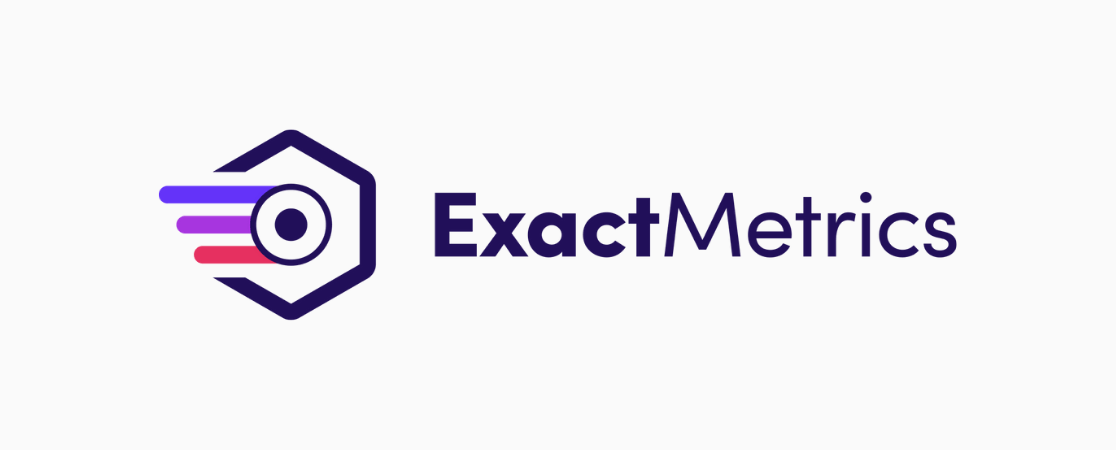Struggling to remember when you launched that email campaign or updated your website? Google Analytics annotations solve this problem by letting you mark significant events directly on your reports, giving crucial context to your data fluctuations.
I’ve been eagerly waiting for this feature, and I’m thrilled to share that Google has officially reintroduced annotations to GA4 in April 2025. This comeback helps businesses connect their activities to performance changes with visual markers right where the data lives.
In this guide, I’ll walk you through everything you need to know about GA4 annotations and share a simpler implementation method for WordPress users.
Understanding GA4 Annotations: What They Are and Why They Matter
GA4 annotations are digital markers that you can place on specific dates in your analytics reports. Think of them as sticky notes for your data that help explain changes or highlight important events.
Before GA4, annotations were a popular feature in Universal Analytics that made tracking the impact of business activities straightforward. When Google released GA4, the absence of annotations was a significant pain point for many analysts and marketers.
Now that annotations have returned to GA4, you can once again create these vital data reference points to provide context for your metrics.
Whether you launch a new email campaign, modify your website design, introduce fresh content, run a promotion, incorporate new affiliate links, or need to document real-world events and offline advertising efforts, annotations provide a convenient way to track and analyze how these events impact your website performance.
Why Adding Context to Your Data Matters
Annotations transform raw numbers into meaningful insights by:
- Connecting cause and effect: Link specific actions to performance changes
- Creating an organized timeline: Build a historical record of your business activities
- Supporting team knowledge sharing: Help everyone understand what happened when
- Improving analysis accuracy: Avoid misinterpreting data fluctuations
- Enhancing reporting clarity: Provide built-in explanations for metric changes
Smart Things to Annotate in Your Reports
Consider adding annotations for:
- Website updates or redesigns
- Content publishing dates
- Email marketing campaign launches
- Social media promotions
- SEO changes or updates
- Price adjustments or sales
- Server outages or technical issues
- Industry events or news
- Competitor actions
- Seasonal factors affecting your business
How Do You Use Google Annotations?
Use Google Analytics annotations to effortlessly jot down notes for yourself or your team and keep track of the activity happening on your site.
How to Use the New Google Analytics Annotations in GA4
Google has integrated annotations directly into GA4’s interface. Here’s how to add them:
Step 1: Navigate to a Chart-Based Report in GA4
Open any GA4 report that displays data in chart form, such as the Acquisition Overview or Engagement reports.
Look for the annotations icon in the top right corner of the chart area.
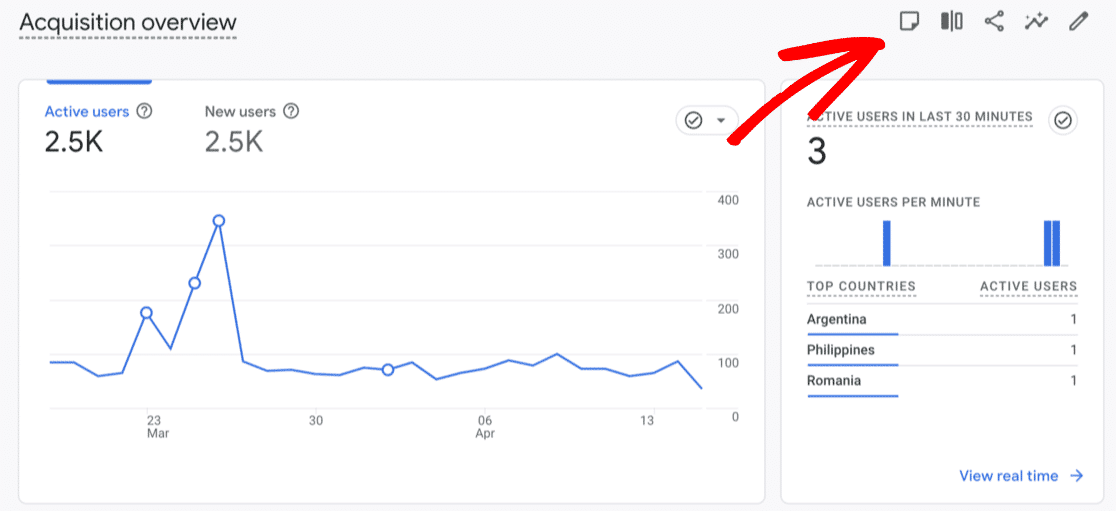
Click this icon to open the annotations panel on the right side of your screen.
Step 2: Create Your First Annotation
In the annotations panel, click the Create annotation button.
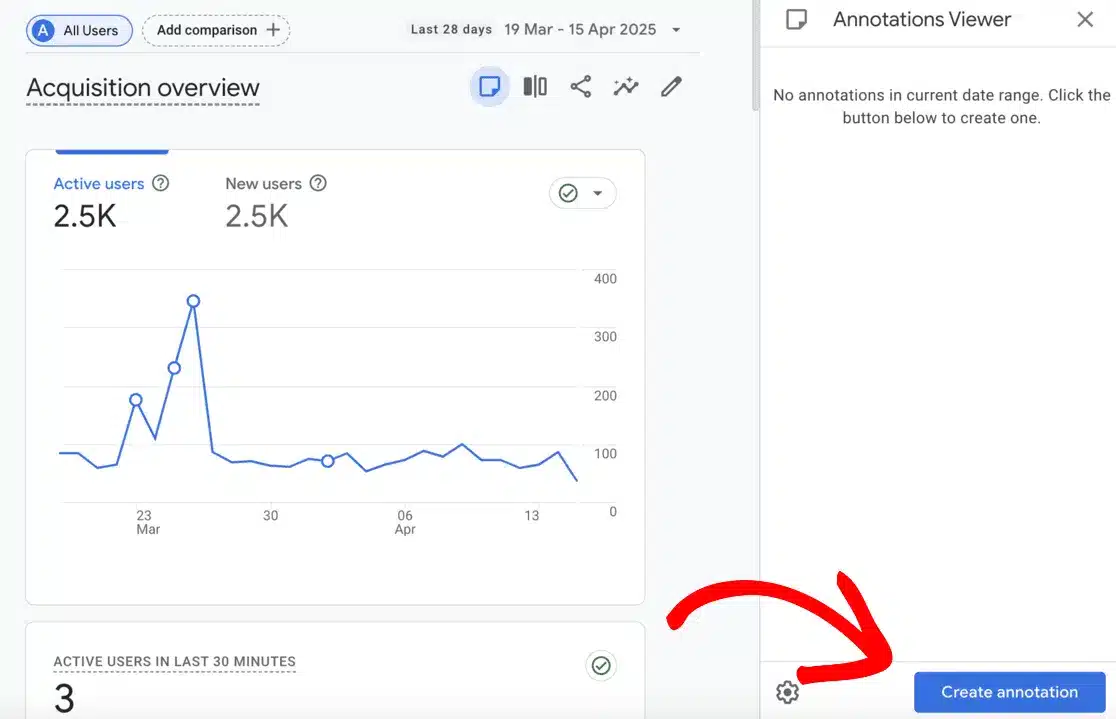
Fill out the annotation form with these details:
- Title: Write a clear, brief description (maximum 60 characters)
- Description: Add additional context if needed (maximum 150 characters)
- Date: Select either a single date or a date range
- Color: Choose a color to categorize or highlight your annotation
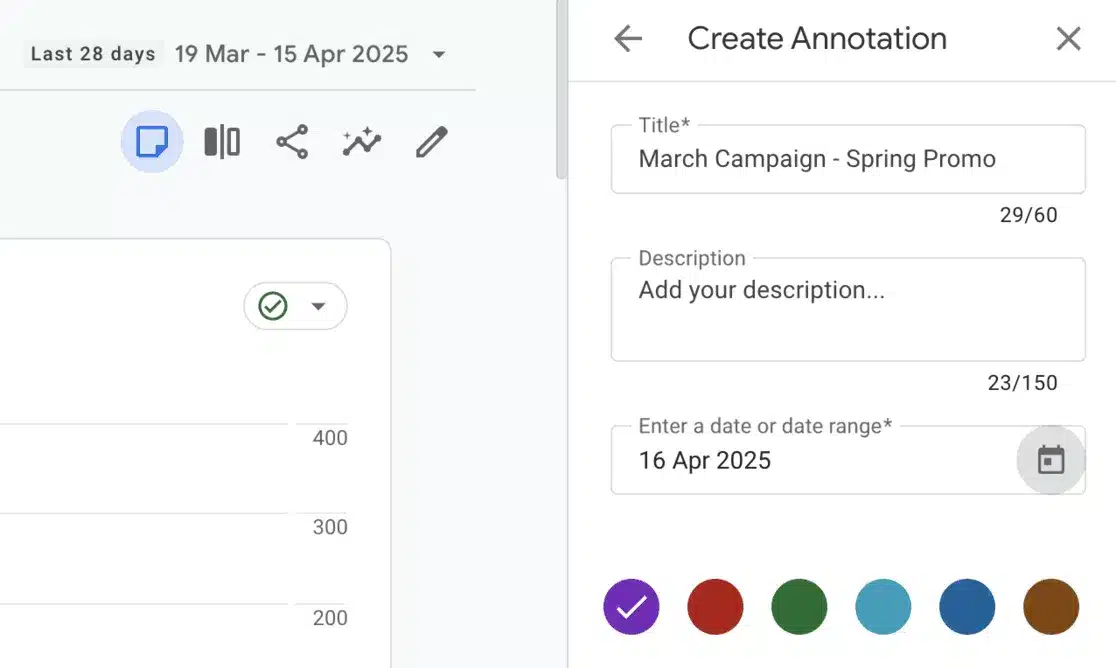
Click Create annotation to save it.
Your annotation will now appear as a colored marker on your chart. Hover over it to see the details:
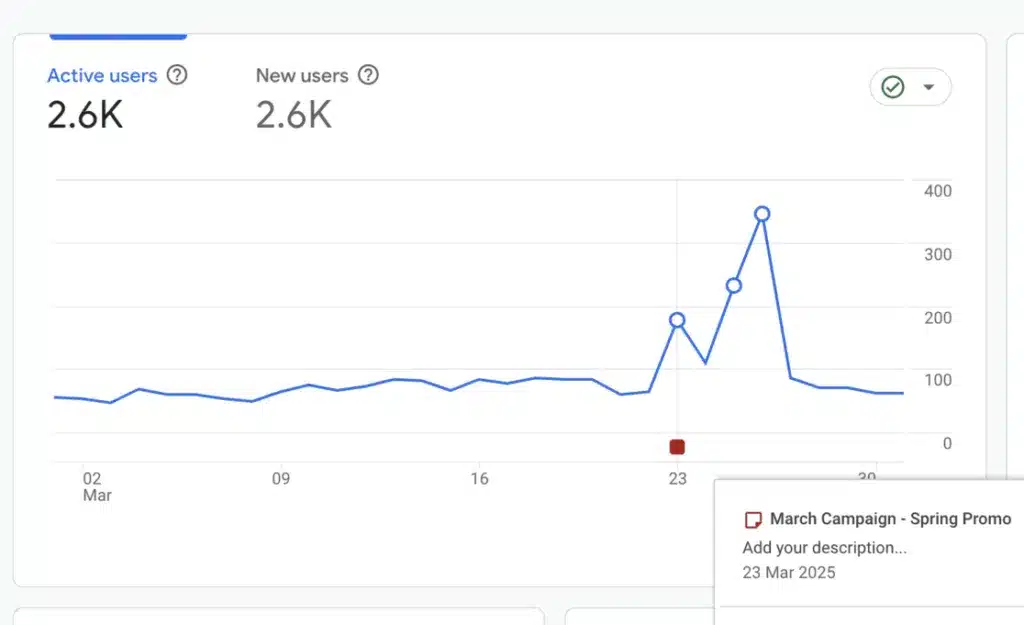
You can edit or delete annotations anytime by returning to the annotations panel.
A Simpler Solution: Managing Annotations in WordPress with ExactMetrics
While GA4’s built-in annotations are useful, WordPress users have access to an even more convenient option through ExactMetrics – the leading WordPress analytics plugin.
The ExactMetrics Site Notes feature offers a seamless way to create and manage annotations without leaving your WordPress dashboard. Best of all, it’s available in the free version of the plugin!
Ready to learn how?
Step 1: Install ExactMetrics
ExactMetrics is the best premium WordPress Analytics plugin, allowing you to easily set up Google Analytics without editing any code or needing a complicated tool like Google Tag Manager.
You get advanced tracking right out of the box with an extremely user-friendly interface and Google Analytics reports right inside your WordPress dashboard.
You can easily add notes to your website’s Google Analytics data using ExactMetrics’ Site Notes feature.
Plus, you can gain access to tons of additional Google Analytics features and advanced tracking capabilities with just a few simple clicks.
Elevate your tracking game and get sophisticated analytics like custom dimension tracking, event tracking, form tracking, outbound link tracking, eCommerce tracking and integrations, and much more, without any complicated configuration or code.
Site Notes is included in every ExactMetrics download, even if you’re using the free version. You can add unlimited notes and involve your entire team without any user restrictions.
That said, upgrading to ExactMetrics Pro unlocks additional Google Analytics features and Site Notes enhancements, such as the ability to:
- Attach files and images to your notes
- Create unlimited custom categories for organizing and managing your notes
- Color code categories for efficient sorting and tracking
- Export any or all of your notes
To add GA4 annotations in WordPress, head to the ExactMetrics pricing page to download and install the plugin.
For a step-by-step tutorial on setting up ExactMetrics, head to How to Add Google Analytics to Your WordPress Site. Want to try it out first? Check out our instructions for the Lite version.
Once you’ve successfully set up the plugin on your site, move on to the next step.
Step 2: Add Google Analytics Annotations
Next, we’ll show you 3 different ways of adding Google Analytics annotations using Site Notes.
Regardless of the method you use, you can always find the annotations you created on your traffic graph, under ExactMetrics » Reports, or in the ExactMetrics » Site Notes section.
Now, let’s see the 3 convenient locations where we can create new annotations in WordPress.
1. Add GA4 Annotations in Your Site Notes Section
To add a new note to your website data and manage your annotations, you can use the Site Notes section in ExactMetrics. Go to your WordPress admin dashboard and click on ExactMetrics » Site Notes.
Press the Add Site Note button to create a new annotation:
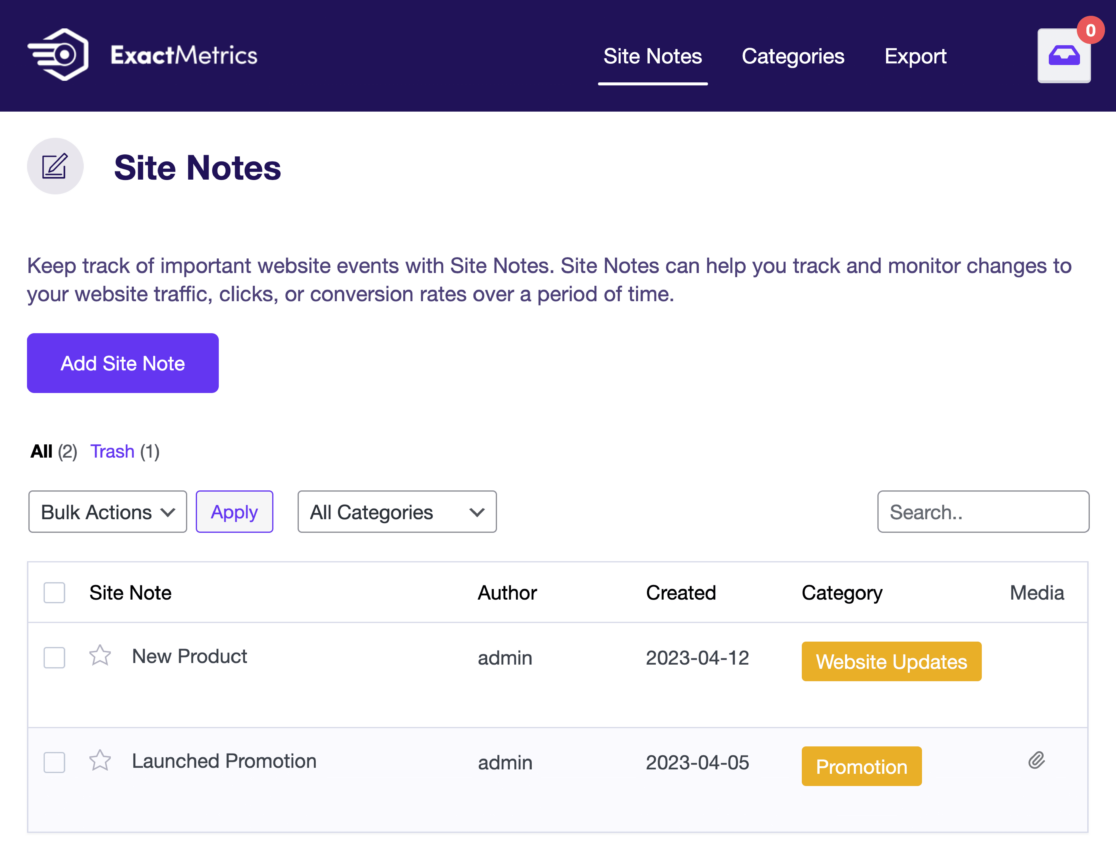
Enter a title for your note and choose a date for the annotation (it can be any time in the past or future). You can also select a category and add media to your note if you’re using ExactMetrics Pro.
If you’d like to flag an annotation as important, just click the star next to the title.
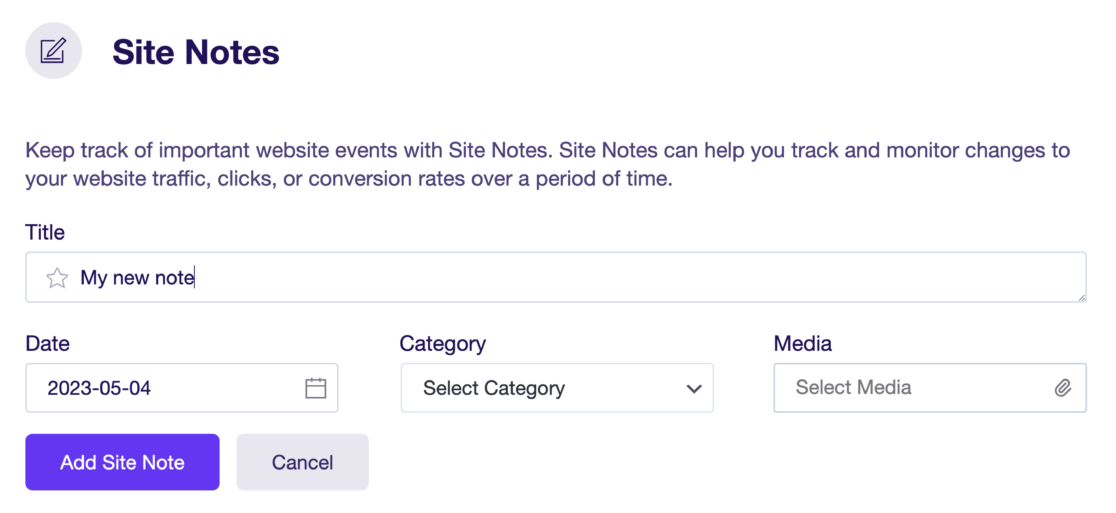
Make sure to click Add Site Note at the bottom to save your new Google Analytics annotation.
With ExactMetrics Pro, you can use Categories to create custom, color-coded categories and manage existing ones. To make a new category, just click the tab at the top, use the Add New Category button, and assign a color.
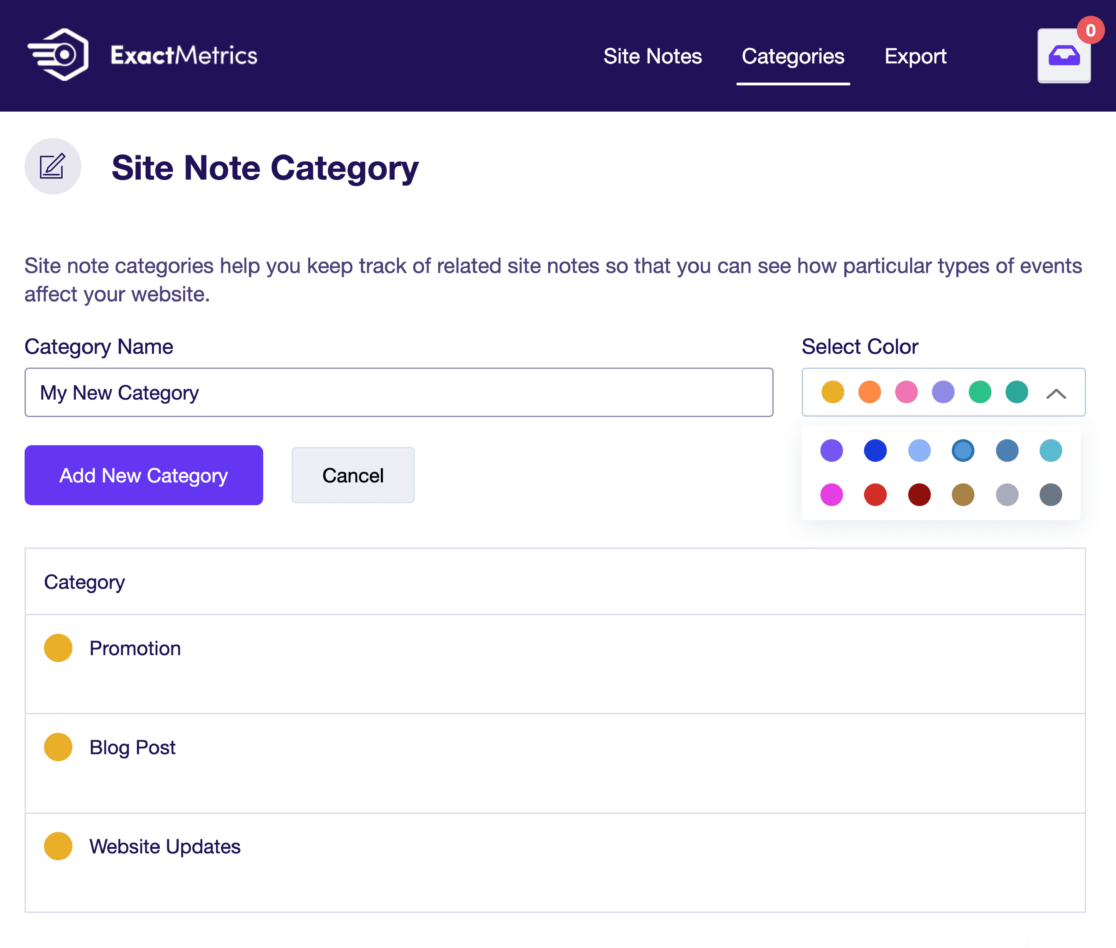
Another Pro feature is the Export tab which you can click to download a CSV file containing all of your notes. It’s a really handy tool if you want to import your Google Analytics annotations into other platforms that support CSV data, like Google Data Studio.
Ready for the next method? We’ll show you how to add GA4 annotations directly to your Google Analytics traffic report.
2. Add Google Analytics Dashboard Annotations
Another way to add Google Analytics annotations is through the dashboard page of ExactMetrics.
In your WordPress admin menu, go to ExactMetrics » Reports. From here, click on the Site Notes option located below your traffic graph to view your annotations and add new ones.
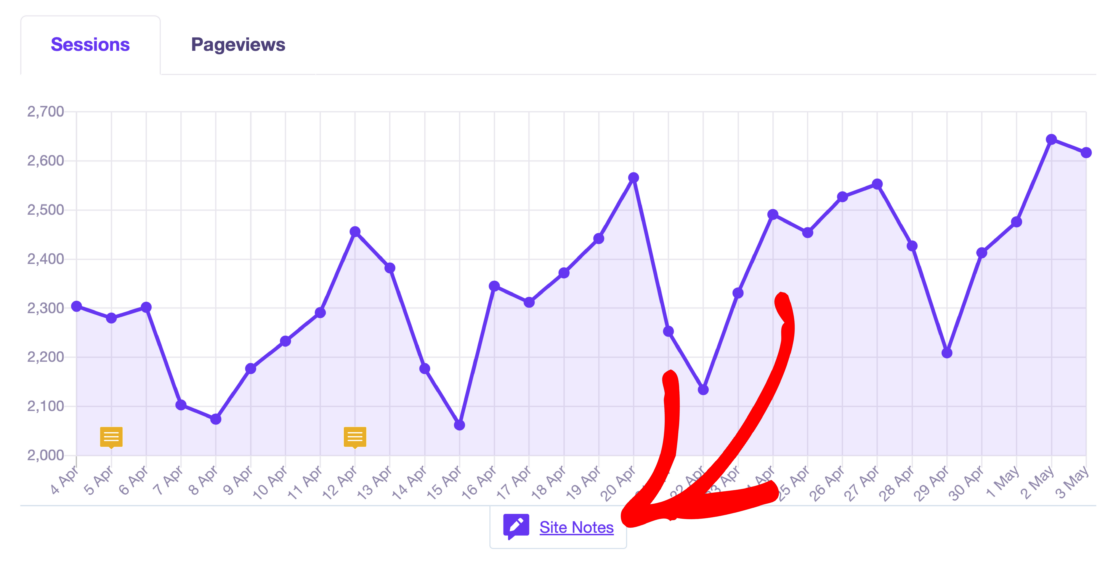
To add a new annotation, click +Add New Site Note. Fill in the details of your GA annotation, such as the title, category, and additional media. When you’re finished, press +Add New Site Note again to save it.
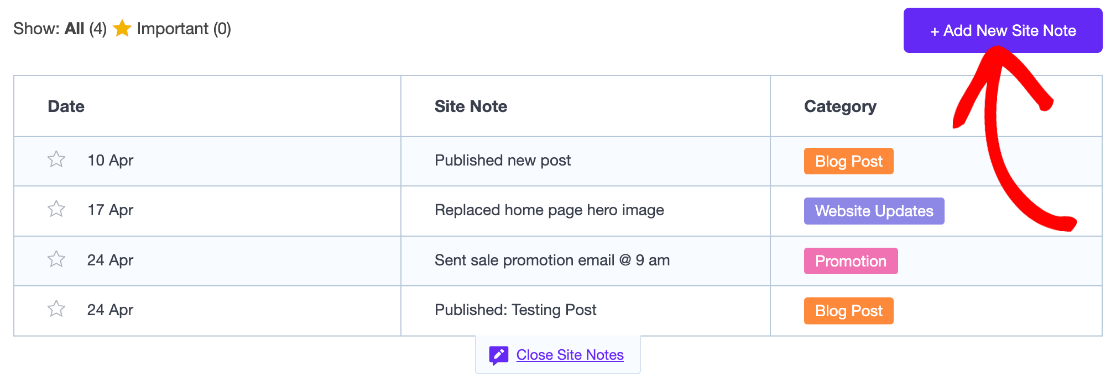
Your new Site Note will immediately appear on the traffic graph above, giving you an easy visualization of how important events impact your site traffic. Just hover over any note icon in the date range on your graph to quickly view individual annotations.
You can also always find your new annotations in the Site Notes section from the previous step. Next, we’ll show you how to add Google Analytics annotations for a new post or page right inside your WordPress editor.
3. Add Google Analytics Annotations in the WordPress Editor
One of the most helpful and time-saving features of Site Notes is its ability to automatically add a new annotation when you publish a post, page, or product, ensuring that you can easily track how new content impacts your web analytics.
To conveniently manage and edit the details of your annotation for a new post or page, look to the right-hand side menu in the WordPress editor. Under the Post section, you’ll notice the ExactMetrics section.
Toggle on the option to Add a Site Note. It will automatically use the page or post title as the annotation label. You can quickly add a description and assign it to a category.
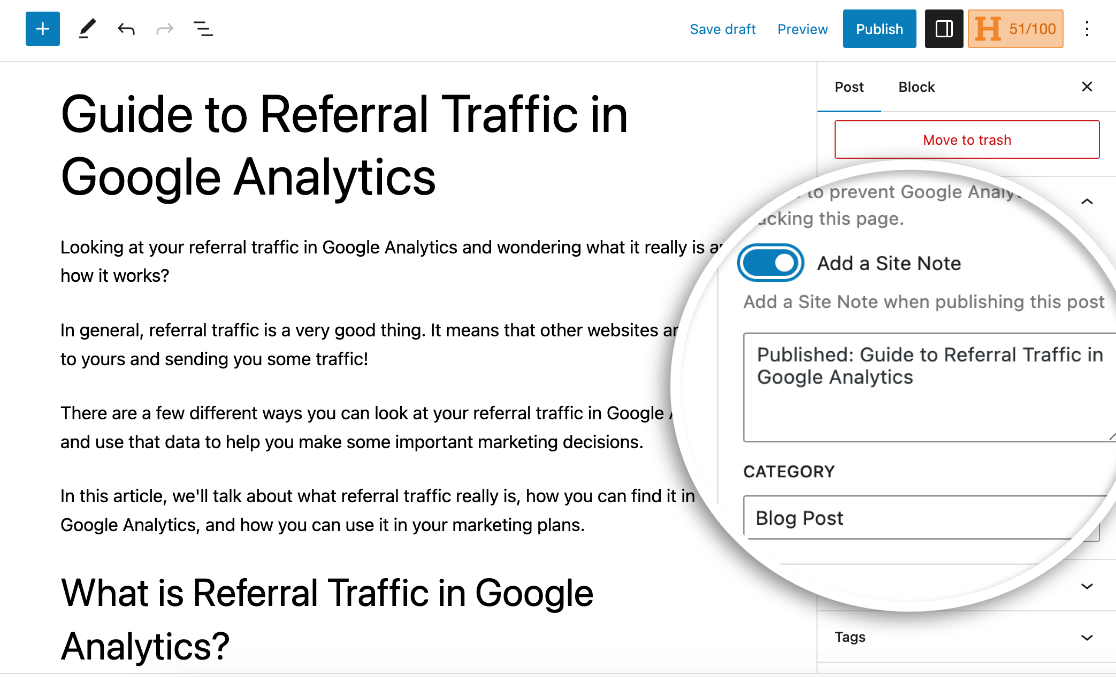
If you ever need to adjust the date or edit annotations created within the WP editor, easily do so within the Site Notes section of ExactMetrics.
Using Site Notes’ automatic feature for new posts and pages is an excellent tool for optimizing your content and SEO. For instance, if you’re using ExactMetrics Pro, you can create separate categories for different types of posts, such as Tutorials, Reviews, Announcements, and more.
When you publish a new post, simply assign it to the appropriate category. Then, you can identify popular post types that generate higher traffic in only a few seconds by looking at your traffic report. Use that information to optimize your current content and create more top-performing post types.
Optimize Your Site with GA4 Annotations
Congrats! You’ve successfully learned how to utilize Google Analytics annotations with GA4 and WordPress.
Now, take advantage of annotations to observe the impact of changes on your website, such as the number of purchases or website visits, and keep your entire team aligned with shared annotations.
Gone are the days of searching through old emails and project calendars to find and remember what happened on your site. Track publishing events, monitor campaigns, gauge your digital marketing efforts or design changes, and much more, all within WordPress.
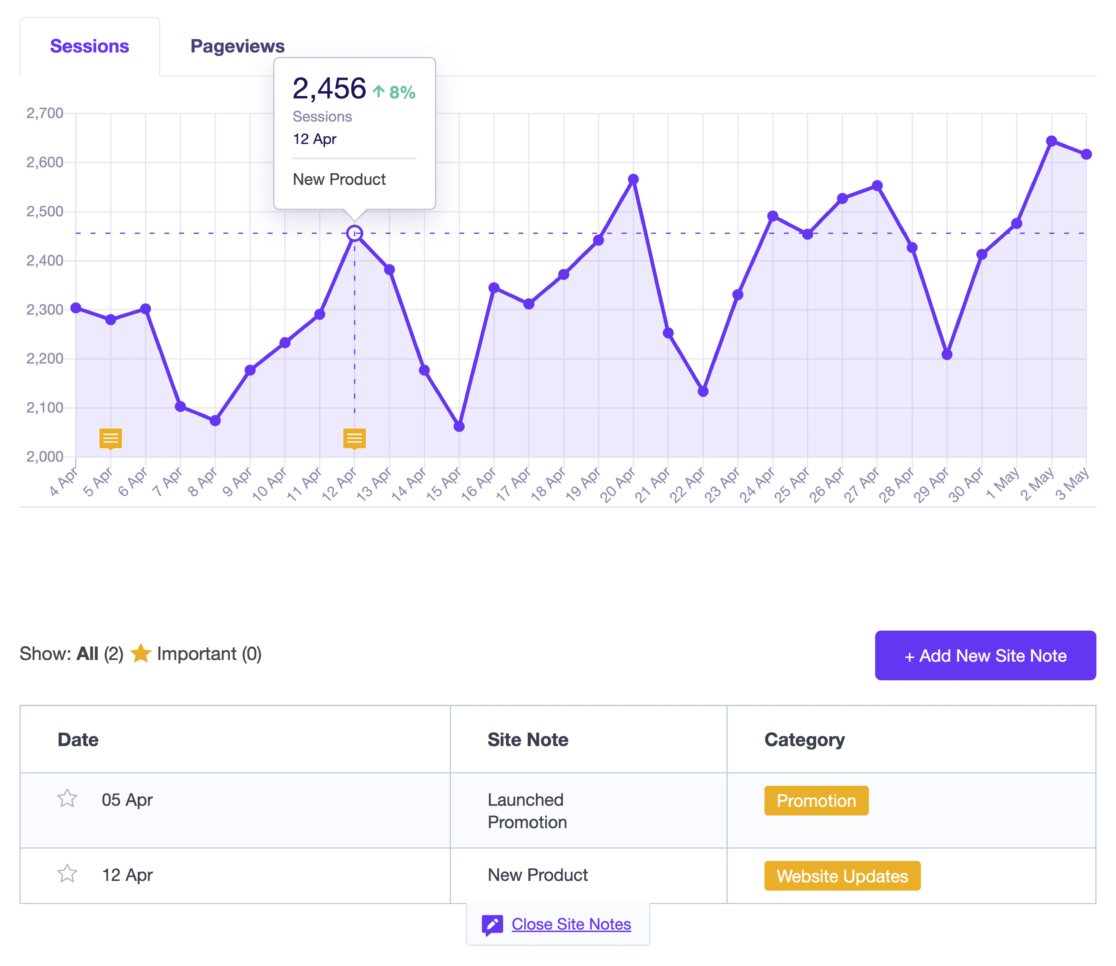
The visibility of the annotations and user access to Site Notes is dependent on the overall permissions granted within ExactMetrics, but there’s no limit to how many notes or users you can have. Manage permissions and user roles by navigating to ExactMetrics » Settings » Advanced.
Quickly look back at the traffic during a promotion – did it perform well enough to replicate? How did a new landing page or design change affect conversions? Did a new Google Ads campaign increase traffic? Does your traffic spike when you publish more Tutorial posts?
Plus, add annotations to future dates to easily see deadlines and upcoming campaigns. As you can see, there are countless ways to use Site Notes to improve your website!
FAQ: Your Questions About GA4 Annotations Answered
How do GA4 annotations differ from Universal Analytics annotations?
GA4 annotations offer improved functionality with color coding options and the ability to span date ranges, which wasn’t possible in Universal Analytics. The interface has also been redesigned for better visibility, with annotations displaying as colored markers on charts rather than small icons.
Can I import my annotations from Universal Analytics to GA4?
Unfortunately, Google hasn’t provided a direct way to migrate annotations from Universal Analytics to GA4. You’ll need to recreate your important annotations in the new system.
Are my annotations visible to everyone with access to the GA4 property?
Yes, annotations in GA4 are visible to all users who have access to the property. This makes them excellent for team collaboration and knowledge sharing.
Is there a limit to how many annotations I can create in GA4?
Google hasn’t specified a limit for the number of annotations you can create. However, for usability, I recommend focusing on significant events rather than annotating every small change.
Do annotations affect my actual analytics data?
No, annotations are purely visual references. They don’t alter your analytics data or how metrics are calculated.
And that’s it!
If you enjoyed learning how to add Google Analytics annotations in GA4 and to your WordPress site using ExactMetrics, you may be interested to learn How to Turn On WordPress Maintenance Mode (Step-by-Step).
Not using ExactMetrics yet? What are you waiting for?
Don’t forget to follow us on Twitter and Facebook to see all the latest reviews, tips, and Google Analytics tutorials.


